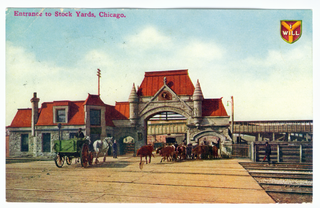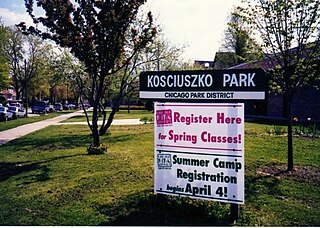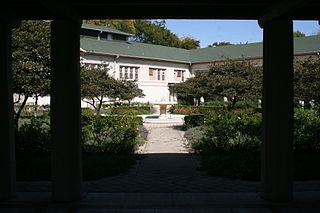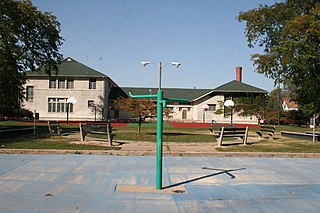
Parks in Chicago include open spaces and facilities, developed and managed by the Chicago Park District. The City of Chicago devotes 8.5% of its total land acreage to parkland, which ranked it 13th among high-density population cities in the United States in 2012. Since the 1830s, the official motto of Chicago has been Urbs in horto, Latin for "City in a garden" for its commitment to parkland. In addition to serving residents, a number of these parks also double as tourist destinations, most notably Lincoln Park, Chicago's largest park, visited by over 20 million people each year, is one of the most visited parks in the United States. Notable architects, artists and landscape architects have contributed to the 570 parks, including Daniel Burnham, Frederick Law Olmsted, Jens Jensen, Dwight Perkins, Frank Gehry, and Lorado Taft.

Woodbridge is a historic neighborhood of primarily Victorian homes located in Detroit, Michigan. The district was listed on the National Register of Historic Places in 1980, with later boundary increases in 1997 and 2008. In addition to its historic value, Woodbridge is also notable for being an intact neighborhood of turn-of-the-century homes within walking or biking distance of Detroit's Downtown, Midtown, New Center, and Corktown neighborhoods.

Palmer Park is an urban park at 201 E. 111th Street on the far South Side of Chicago, Illinois, USA.

Calumet Park is a 198-acre (79-hectare) urban park in Chicago, Illinois. Providing access to Lake Michigan from the East Side neighborhood on the city's Southeast Side, the park contains approximately 0.9 miles (1.5 km) of lake frontage from 95th Street to 102nd Street, which extends to the city limits, the Illinois' border with Indiana. The park is listed on the National Register of Historic Places.

The Union Stock Yard Gate, located on Exchange Avenue at Peoria Street, was the entrance to the famous Union Stock Yards in Chicago. The gate was designed by Burnham and Root around 1875, and is the only significant structural element of the stock yards to survive. It was designated a National Historic Landmark in 1981. The plaza surrounding the gate also includes the city's principal memorial to its firefighters.

Washington Park is a 372-acre (1.5 km2) park between Cottage Grove Avenue and Martin Luther King Drive, located at 5531 S. Martin Luther King Dr. in the Washington Park community area on the South Side of Chicago. It was named for President George Washington in 1880. Washington Park is the largest of four Chicago Park District parks named after persons surnamed Washington. Located in the park is the DuSable Museum of African American History. This park was the proposed site of the Olympic Stadium and the Olympic swimming venue for Chicago's bid to host the 2016 Summer Olympics. Washington Park was added to the National Register of Historic Places on August 20, 2004.

Washington Square, also known as Washington Square Park, is a park in Chicago, Illinois. A registered historic landmark that is better known by its nickname Bughouse Square, it was the most celebrated open air free-speech center in the country as well as a popular Chicago tourist attraction. It is located across Walton Street from Newberry Library at 901 N. Clark Street in the Near North Side community area of Chicago, Illinois, United States. It is Chicago's oldest existing small park. It is one of four Chicago Park District parks named after persons surnamed Washington. It was added to the National Register of Historic Places on May 20, 1991.

The Printing House Row District is a National Historic Landmark District encompassing four architecturally important buildings on South Dearborn Street, between Jackson Boulevard and Ida B. Wells Drive, in the Loop community area of Chicago, Illinois. It was listed on the National Register of Historic Places as South Dearborn Street – Printing House Row Historic District and listed as a National Historic Landmark as South Dearborn Street – Printing House Row North Historic District on January 7, 1976. The district includes the Monadnock Building, the Manhattan Building, the Fisher Building, and the Old Colony Building.

Portage Park is a 36-acre (15 ha) park in the Portage Park community area of Chicago, Illinois on the National Register of Historic Places. The park stretches from Irving Park Road on the south to Berteau Avenue between Central and Long Avenues. The largest public park on Chicago's Northwest Side, it has many recreational facilities including six tennis courts, two playgrounds, a slab for in-line skating, a bike path, a nature walk, five baseball fields, two combination football/soccer fields and two fieldhouses— one housing a gymnasium and the other a cultural arts building. The park also has an Olympic-size pool featuring a large deck for sunning, misting sprays, as well as an interactive water play area with slide and diving boards in addition to a smaller heated pool. Plans are currently underway for the development of a new, 6,500-square-foot (600 m2) senior center at Portage Park.

Jefferson Park is a 7-acre (2.8 ha) park in the Jefferson Park community area of Chicago, Illinois on the National Register of Historic Places.

Indian Boundary Park is a 13-acre (5.3 ha) urban park in the West Ridge neighborhood of North Side, Chicago, Illinois.

Prairie Avenue is a north–south street on the South Side of Chicago, which historically extended from 16th Street in the Near South Side to the city's southern limits and beyond. The street has a rich history from its origins as a major trail for horseback riders and carriages. During the last three decades of the 19th century, a six-block section of the street served as the residence of many of Chicago's elite families and an additional four-block section was also known for grand homes. The upper six-block section includes part of the historic Prairie Avenue District, which was declared a Chicago Landmark and added to the National Register of Historic Places.

Pulaski Park is a park in the West Town neighborhood of Chicago, Illinois. It was founded in 1912, and was named after American Revolutionary War hero Casimir Pulaski.

Kosciuszko Park is a park located at 2732 N. Avers Ave. Situated along the northern boundary of Chicago's Logan Square community area at Diversey, it is heavily frequented by residents of Avondale and is considered to be part of Jackowo.

Sherman Park is a sixty-acre park in the New City neighborhood of South Side, Chicago.

Hamilton Park is a public park at 513 W. 72nd Street in the Englewood neighborhood of Chicago, Illinois. The park opened in 1904 as part of a plan led by the South Park Commission to add small neighborhood parks on Chicago's South Side. It was the first public park in Englewood. Landscape designers the Olmsted Brothers and architecture firm D. H. Burnham & Company collaborated on the park's design. The park opened with a fieldhouse, baseball field, wading pool, and walkways; within the decade, the designers added gymnasiums, a playground, and tennis courts. The fieldhouse has a Beaux-Arts design, and its inside features several murals of prominent figures in American history. The park was heavily used after it opened, and the fieldhouse in particular was booked so consistently that it was expanded in the 1920s.

Fuller Park is a public park at 331 W. 45th Street in the neighborhood of the same name in Chicago, Illinois, United States. The park was one of several built by the South Park Commission in the early 20th century to provide parks in dense and poor South Side Chicago neighborhoods which lacked them. While most of the South Park Commission parks opened in the mid-1900s, work on Fuller Park did not begin until 1910 due to a dispute over its location, and its facilities gradually opened over the next four years. The park was named for Melville Fuller, an Illinois native and former Chief Justice of the United States. The South Park Commission designed the park's landscape in a similar style to their earlier parks, which had been designed by the Olmsted Brothers; D. H. Burnham and Company designed its buildings, as they had for the earlier parks. The park originally included a Beaux-Arts fieldhouse, a gymnasium, a bathhouse, a grandstand, and a running track and walking paths. Fuller Park was first settled by Irish immigrants in the later 1860s after the Union Stock Yards opened on Christmas Day 1865. This area became a part of the Lake Township area and after the Great Chicago Fire of 1871 and the opening of the Lake Shore & Michigan Southern Railroad the area flourished into a community.

Davis Square is a public park located between 44th and 45th Streets and Marshfield and Hermitage Avenues in the New City community area of Chicago, Illinois. The park opened in 1905 as one of the initial parks in the South Park Commission's plan to build parks in the dense, poor neighborhoods of Chicago's South Side. It was named for Nathan Smith Davis, a Chicago physician and one of the founders of the American Medical Association. As they did for most of the South Park Commission's parks, the Olmsted Brothers designed Davis Square's landscape, while D. H. Burnham and Company designed its facilities. The park initially included a Beaux-Arts styled fieldhouse, a swimming pool and pool house, baseball fields, and walking paths.

Cornell Square is a public park at 1809 W. 50th Street in the New City community area of Chicago, Illinois. Opened in 1905, the park was one of many planned by the South Park Commission to provide parks in dense, poor South Side neighborhoods. The park was named for Paul Cornell, one of the Commission's board members. As with the South Park Commission's other early parks, landscape architects the Olmsted Brothers designed the park's layout while D. H. Burnham and Company designed its facilities. The park originally included a fieldhouse with gymnasium facilities, a swimming pool, athletic fields, and walking paths. The fieldhouse has a Beaux-Arts design and includes a painting of Ezra Cornell, the founder of Cornell University and Paul Cornell's cousin.

Grand Crossing Park is a public park at 7655 S. Ingleside Avenue in the Greater Grand Crossing neighborhood of Chicago, Illinois. Opened in 1915, the park was planned by the South Park Commission, which was responsible for adding several parks in dense, poor South Side neighborhoods. While the South Park Commission designed the park and its facilities in-house, its designs were heavily influenced by the work of the Olmsted Brothers and D. H. Burnham and Company in its earlier parks. The park originally included a Beaux-Arts fieldhouse, a swimming pool, outdoor gymnasiums, a baseball field, tennis courts, and running and walking paths. The fieldhouse includes indoor gymnasiums, meeting rooms, and a series of murals titled An Allegory of Recreation.























